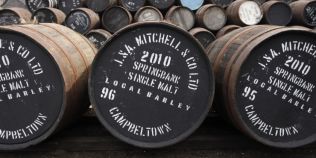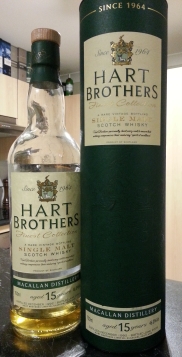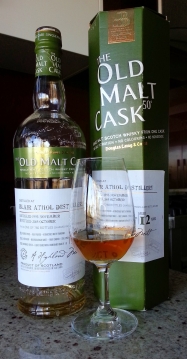My wife brought me home the remains of some Scotch Malt Whisky Society tasting bottles that escaped the clutches of the Australian tasting panel (thanks Andrew!). Not quite the crumbs from the table when we are talking about some very rare single cask, cask strength whiskies from one of the great independent bottlers of the whisky world. Particularly whiskies coming from three diverse and rather uncommon distilleries. Suffice it to say, I was very excited.
The SMWS tasting panel samples hundreds of casks each year and only a select number are chosen to be bottled and imported to Australia. In this case, and subject to confirmation, I believe the three samples were ultimately bottled as the following: (Mortlach) 76.112 “Spiced Champurrado”, (Glenlossie) 46.22 “An Italian Kitchen”, and (Springbank) 27.106 “A boiler suit in ballet shoes”. The Springbank I had previously sampled at the winter SMWS tasting event in Sydney and it was my favourite dram of the night, so I was very pleased to find this showing up unbidden at my doorstep.
The first two are mature Speysiders and find expression predominantly through independent bottlings. Mortlach has long been favoured by blenders for its complexity and heartiness created by a rather unorthodox combination of stills and the use of tradition wormtubs in condensing the spirit. The owners release a regular 16 year old “Flora and Fauna” edition and the occasional rare malt, but most of the spirit finds its way into blends, and if you are lucky enough to stumble across one, chances are it will be by an independent bottler.
Glenlossie, like Mortlach, belongs to the Diageo fold and is offered as a standard 10 year old. Although built in 1876 it remains a rather unknown distillery despite being a staple in the majority of the Haig blends. This was my first taste of a Glenlossie single malt and I was not disappointed.
The last whisky, the Springbank, comes from one of the three remaining active distilleries in Campbelltown. Springbank is renowned for its firmly traditional and artisanal approach to producing whisky and, along with Kilchoman, is one of only two distilleries that perform each stage of whisky production on the same premises – from the malting of the barley to bottling the final product.
Mortlach 1986 – 27yr. (Bottled as SMWS 76.112 “Spiced Champurrado”)
Bottled 23/09/13
58.1% ABV
Cask 2041
10CL SMWS sample bottle
Nose: A little musty, feels almost arid. Lacquer. Dried herbs – thyme, touch of rosemary. Slightly metallic – aluminium scouring brush.
Becomes oakier with time in the glass. Honey notes emerge with water. Shandy.
Palate: Sweet and gamey. Venison in a port reduction. Honey-glazed cashews. Just a hint of some citrus in there – candied orange peel. Bergamot tea. Lavender. Grains of paradise? Complex but subtle palate. (Refill sherry cask?).
With water some of this complexity is lost, but a honeycomb sweetness surfaces and the palate becomes more rounded.
Finish: Not particularly long. A quirky dialogue between the sweeter elements and a savoury meatiness. Bay leaves and oak are left on the fade, becoming quite dry. There’s a slightly chlorinated note, but it’s not at all off-putting.
Thoughts: A fascinating drop offering rather disparate elements, some a little unusual. There isn’t a solid core to latch onto with this drop, but age has instead imparted a lot of complexity to Mortlach’s often idiosyncratic spirit. I’m not immediately sold, but am left intrigued, feeling this is a whisky that may take some time to get to know and appreciate but with reward.
83/100
Glenlossie 1992 – 20yr (Bottled as SMWS 46.22 “An Italian Kitchen”)
Bottled 16/07/13
50.7% ABV
Cask 3000966
10CL SMWS sample bottle
 Nose: Very closed at first. Wet paint and waxy crayon. Really needs to breathe. Opens up with some praline. Quite malty. Old hay and hessian sacks.
Nose: Very closed at first. Wet paint and waxy crayon. Really needs to breathe. Opens up with some praline. Quite malty. Old hay and hessian sacks.
Palate: Flash of a mineral note. Chamomile tea. Then wow! This is the peachiest palate I’ve ever tasted on a scotch. Rich skins of ripe yellow nectarine. Very fruity – some guava and tropical elements on top of the orchard fruits. Gentle and floral but incredibly sweet. Quite rich but refreshing. Not at all anticipated by the nose!
Finish: Medium finish with the predominant peach flavour dissipating into green tea. Only a nod to the oak, which is perhaps surprising given its age. Likely a bourbon cask, but many of these vibrant fruity notes are reminiscent of a quality sauternes maturation.
Thoughts: A real disconnect between the nose and the palate. The former very closed and austere, but the palate a deluge of fresh, invigorating flavours. For an introduction to this distillery, one couldn’t be more impressed! [By the time I had sampled this and realised it was bottled and brought in by SMWS, it was long sold out. Disappointing, but in this case it did save me $293]
87/100
Springbank 2000 – 13yr (Bottled as SMWS 27.106 “A boiler suit in ballet shoes”)
Bottled 22/01/14
49.8% ABV
Cask 164
10CL SMWS sample bottle
Nose: Peat and whiff of smoke – dry and minerally. Sweet, light sherry. Limes. (If I were to give this a quirky SMWS name of my own it would be: Key-lime pie in a woodfired oven). Golden raisons. Oily; inky. Golden syrup and cinnamon.
Taste: Immediate peat – zingy and clean. Very pastry/cake-like… Cinnamon cake or German carrot cake. Gingersnap biscuits. Chewy toffee. Mouthfeel is rich, full, and syrupy.
Finish: Long, layered and sweet. Still very mouth-coating. Plenty of wood, becoming nutty.
Thoughts: A quick look at the ABV will tell you this was a very active cask given its modest age and this is evident in the ample richness of this whisky. There is certainly no need for water, in fact it drowns easily. This whisky is just a great example of Springbank at its best, even at a fairly modest age.
91/100












